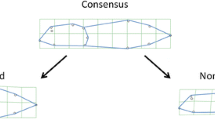Abstract
Predator-induced defenses are well studied in plants and invertebrate animals, but have only recently been recognized in vertebrates. Gray treefrog (Hylachrysoscelis) tadpoles reared with predatory dragonfly (Aeshnaumbrosa) larvae differ in shape and color from tadpoles reared in the absence of dragonflies. By exposing tadpoles to tail damage and the non-lethal presence of starved and fed dragonflies, we determined that these phenotypic differences are induced by non-contact cues present when dragonflies prey on Hyla. The induced changes in shape are in the direction that tends to increase swimming speed; thus, the induced morphology may help tadpoles evade predators. Altering morphology in response to predators is likely to influence interactions with other species in the community as well.
Similar content being viewed by others
Author information
Authors and Affiliations
Additional information
Received: 17 April 1996 / Accepted: 18 September 1996
Rights and permissions
About this article
Cite this article
McCollum, S., Leimberger, J. Predator-induced morphological changes in an amphibian: predation by dragonflies affects tadpole shape and color. Oecologia 109, 615–621 (1997). https://doi.org/10.1007/s004420050124
Issue Date:
DOI: https://doi.org/10.1007/s004420050124




